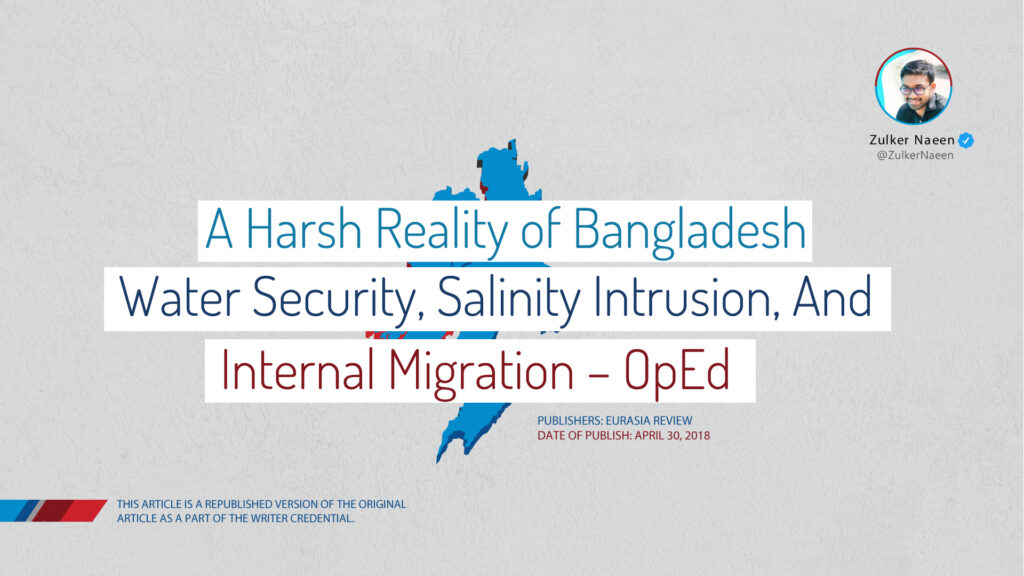Over the past 35 years, salinity intrusion in Bangladesh has increased by about 26 per cent, with the affected area expanding each year. A combination of tidal flooding, inundation by storm surges and saltwater intrusion has led to a rise in salinity in the groundwater and the fresh-water ponds.

A Harsh Reality Of Bangladesh: Water Security, Salinity Intrusion, And Internal Migration – OpEd
Publishers: Eurasia Review
Date of Publish: April 30, 2018
In recent years, development experts around the world are intensely concerned about water security. According to FAO, a third of the world’s population depends on groundwater. The UN has already warned of the danger of overusing these reserves. Groundwater reserves in part of India’s Ganges basin could be drained dry within decades, it says.
However, we are overlooking the harsh reality of Bangladesh.
The melting of glaciers and snowpack in the Himalayas has swollen the rivers that flow into Bangladesh from Tibet, Nepal, Bhutan, and India. Also, India diverts large quantities of water for irrigation during the dry season and release most water during the monsoon season.
The Ganges–Brahmaputra Delta already has identified as one of the hot spots of climate change effects. It laid Bangladesh in a most vulnerable situation, which has already brought droughts that lead to acute water shortages and affect agricultural output.
Equally, Bangladesh has to face a severe flood every four to five years. Rapid erosion of coastal areas has inundated dozens of islands in the Bay. Last two decades, we have already lost 90 per cent of Sandwip Island’s original 23-square-miles. In recent years, riverbank erosion is displacing between 50,000 and 200,000 people annually.
Among other South Asian countries, Bangladesh should receive the utmost attention because of climate risks and water security. It is expected, about 15 million people from Bangladesh only could be on the move by 2050 because of climate migration.
Over the past 35 years, salinity intrusion in Bangladesh has increased by about 26 per cent, with the affected area expanding each year. A combination of tidal flooding, inundation by storm surges and saltwater intrusion has led to a rise in salinity in the groundwater and the fresh-water ponds.
About 70 per cent of people in the region depend on pond water for drinking and domestic use, as the groundwater is extreme saline, according to Golam Rabbani, a fellow at the Bangladesh Centre for Advanced Studies.
According to the World Bank, climate change is likely to increase river and groundwater salinity dramatically by 2050 and exacerbate shortages of drinking water and irrigation in the southwest coastal areas of Bangladesh.
It will adversely affect the livelihoods of at least 2.9 million poor people in a region where 2.5 million people are already struggling with a lack of water.
“We can’t drink the saline water, can’t take a bath with it. If the utensils washed with this water, they get damaged, even for cooking, we have to bring water from far,” says Khadija. The impact of the acute drinking water crisis in Bangladesh is borne disproportionately by women who, like Khadija, are the family members traditionally responsible for collecting water.
Already, internal migration has observed strongly; a large population is already being displaced or has decided to migrate due to water salinization, cyclones and riverbank erosion. We found many migration stories from the southern region Satkhira, Kuakata, Shoronkhola, and Potuakhali district of the country.
The increasing salinity of the soil in coastal villages has not just made safe drinking water hard to come by; it has also made rice farming, the region’s traditional occupation, nearly impossible. Landless labourers face livelihood challenges and have large households with many dependents who are most likely to migrate. Rabbani explains. “About 90 per cent of the people who migrate are men, leaving the female members of the household behind.”
According to the World Bank, it has estimated that 400,000 people from different parts of Bangladesh move to Dhaka each year. International Organization for Migration surveyed 160 migrant households in Dhaka, around 66 per cent said that they migrated because of changing climate conditions and environmental hazards.
However, sea-level rise has resulted in the loss of hundreds of acres of mangroves across coastal Bangladesh. Further loss of mangrove habitat, especially in the Sundarbans, means that Bangladesh will lose one of its last natural defences against climate change-induced super-cyclones.
Engineering adaptations to climate change, such as the construction of dykes is not a sustainable solution in Bangladesh because the soils are sandy and constantly shifting. However, it has financed 4,000 miles of coastal embankment projects to adapt to climate change.
So, Bangladesh needs to send the message out loud and clear to the entire world about the absolute need to confront this harsh reality head-on.
Zulker Naeen, the writer, a communication graduate from the University of Liberal Arts Bangladesh (ULAB), is a freelance journalist at Climate Tracker. naeenzulker@gmail.com
References
Bagri, N. (2017). Bangladesh’s water crisis: A story of gender. Doha: Aljazeera.
Bhalla, N. (2018). World Has Not Woken Up to Water Crisis Caused by Climate Change. New Delhi: Thomson Reuters Foundation.
Glennon, R. (2017). The Unfolding Tragedy of Climate Change in Bangladesh. New York: Scientific American.
Gremmel, R. (2018). The world’s taps are rapidly running dry. Johannesburg: Mail & Guardian.










